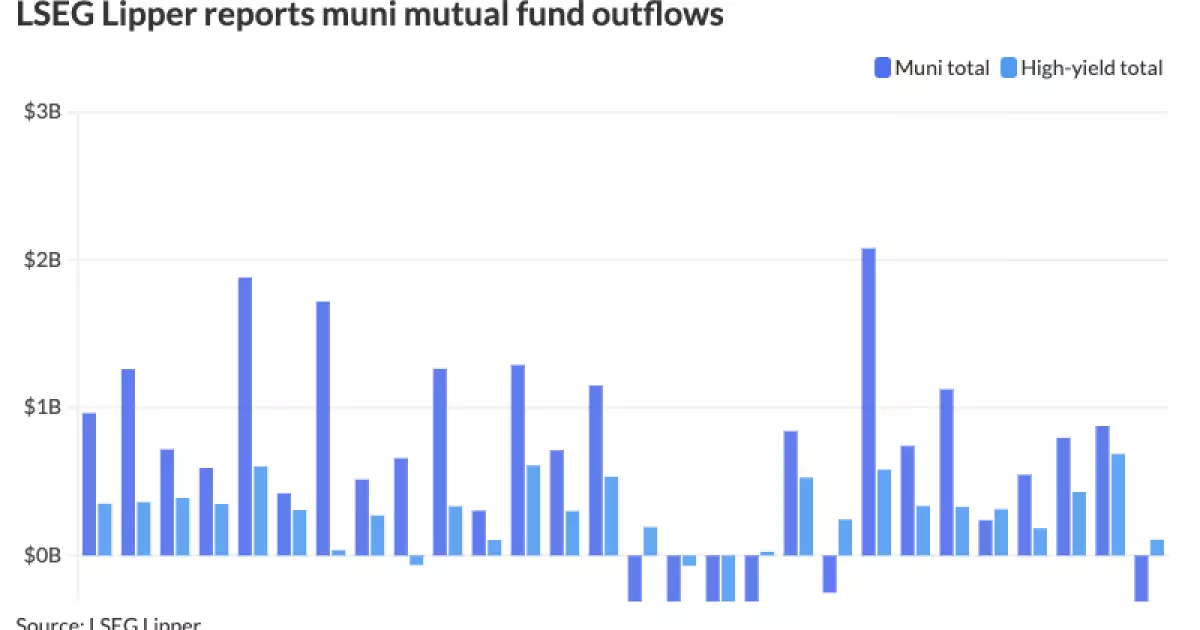Municipal bonds have long been considered a reliable investment vehicle for many, especially during turbulent economic times. However, the recent trends suggest a concerning trajectory, marked by rising yields and a chilling effect on investor sentiment. Last Thursday, the municipal bond market sustained further losses, albeit not as severe as the previous day’s substantial selloff. The data paints a picture of a market grappling with fundamental inefficiencies driven by elevated supply levels and a noteworthy decline in investor demand. Analysts like Kim Olsan from NewSquare Capital summarize the situation concisely: “more supply than demand.” This simple phrase encapsulates a scenario that demands scrutiny.
Market Dynamics: Supply Constraining Demand
The primary forces at play in the municipal market can largely be traced back to supply and demand imbalances. As municipalities race to issue new bonds, the market is flooded with fresh debt, creating downward pressure on prices. Olsan points out critical elements weakening municipal fundamentals—light redemptions and the approaching tax season complicate matters even further. If the current trend holds, we might enter a protracted period where supply significantly outpaces demand, leading to a continuous evaporation of investor confidence.
What is especially troubling is the risk of volatility in the market further exacerbating the situation. In an environment where the 10-year AAA spots are retracing significantly from prior benchmarks, the stability that municipal bonds once represented seems to be tenuous at best. With long-term yields nudging closer to 4.25% and encroaching tax implications, the allure of tax-exempt municipal bonds diminishes.
Political Uncertainties: A Volatile Catalyst
Compounding the existing challenges is the unpredictable political climate in Washington, D.C. The current administration has adopted what many describe as a “no holds barred” policy stance that resonates deeply across both domestic and foreign economic landscapes. The implications of this approach reach the municipal market directly. According to Jeff Lipton, a market strategist, factors such as looming trade wars and the potential repeal of muni tax exemptions create an air of trepidation that is hard to shake off.
Political risks that can derail the foundations of municipal investing are no small matter. Should the tax exemption be repealed or curtailed, we could witness a substantial decline in demand for these bonds, as both retail and institutional investors re-evaluate their portfolios. In a rising rate environment, the attractiveness of taxable bonds increases, posing an existential challenge for an already beleaguered munis market.
The Emotional Landscape of the Investor
One crucial factor often overlooked in financial analyses is the psychological element at play. Investors are notoriously reactive to market volatility, and with uncertainty coming from multiple fronts—political, economic, and social—the emotional weight can lead to irrational decisions. Timlin’s observation regarding the cautious tone among market participants makes perfect sense; the psychological effects of uncertainty often prompt investors to pull back when they ought to be capitalizing on long-term opportunities.
The recent $373 million outflow from municipal bond mutual funds signals that the average investor may be adopting a more conservative posture in light of ongoing volatility. This retreat could lead to a self-perpetuating cycle where declining demand results in falling prices, which in turn discourages further investment.
Infrastructure Needs vs. Political Will
On the ground, the case for investing in municipal bonds is being undermined by an urgent need for infrastructure improvement. As Lipton rightly notes, much of the nation’s infrastructure is falling behind standards and requires investment to ensure public safety and national security. But how can we address these pressing needs when financial uncertainty pushes investors towards safer, albeit lower-yielding assets?
The paradox is glaring: the upfront costs of improving infrastructure could be mitigated through financing options that include municipal bonds, yet the prevailing apprehension that surrounds them stalls these initiatives. This inability to strike a balance between pressing needs and fading investor confidence may prove detrimental in the long run.
The High-Yield Attraction Amidst Peril
Interestingly enough, it appears that high-yield municipal funds are garnering their own share of attention, as evidenced by the reported $107.4 million inflow into these funds over the last week. While this demonstrates a willingness among some investors to seek higher-risk opportunities, it doesn’t necessarily speak to a healthier overall market. In fact, the gravitation toward high-yield options could simply reflect a desperate search for yield in a low-return landscape.
Yes, there are investments to be made, but they often come at a premium—financially and emotionally. This unease, compounded with political and market volatility, paints a picture that is anything but rosy for municipal bond investors. As we navigate these waters, it remains to be seen whether the municipal bond market can regain its footing amidst swirling uncertainties. Will the desire for higher yields lead to greater instability, or can a stabilizing force emerge to avert a deeper crisis? One thing is certain: the coming months will be pivotal in determining the path municipal bonds will take.

